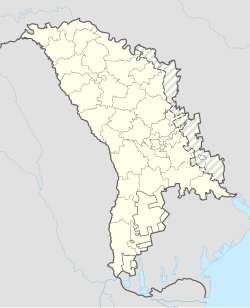Orhei
Orhei | |
|---|---|
| Coordinates: 47°23′N 28°49′E / 47.383°N 28.817°E | |
| Country | Moldova |
| County | Orhei District |
| Area | |
| • Total | 8.5 km2 (3.3 sq mi) |
| Population | |
| • Total | 21,065 |
| • Density | 2,500/km2 (6,400/sq mi) |
| Time zone | UTC+2 (EET) |
| • Summer (DST) | UTC+3 (EEST) |

Orhei (Romanian pronunciation: [orˈhej]), also formerly known as Orgeev (Russian: Орге́ев), is a city, municipality[2] and the administrative centre[3] of Orhei District in the Republic of Moldova, with a population of 21,065. Orhei is approximately 40 kilometres (25 miles) north of the capital, Chișinău.
History
Orhei takes its name from the Hungarian Őrhely, lit. 'guard post', as it was an outpost of the Hungarian army guarding the gyepű.[4] It was the Ottoman-occupied military center of northern Bessarabia until it was ceded to the Russian Empire in 1812.[citation needed] The word "orhei" was used by local population, meaning "strengthened hill, fortress, deserted courtyard".[5] The name "Orhei" is, derived from the Hungarian word Őrhely or Várhely, the earlier meaning "lookout post", dating from the 13th century, when Hungarian forces built a series of defences in the area.[6] Orhei gets its name from Orheiul Vechi, an active monastery near the village of Ivancea.
Like the rest of Bessarabia, Orhei was taken by the Kingdom of Romania after World War I and was annexed by the USSR in 1940. It was liberated from Axis forces on 6 April 1944, during the Uman–Botoșani Offensive, and was rebuilt after the war. In 1991 it became part of the Republic of Moldova.
Prior to 2003, Orhei was the capital of Orhei County, a large administrative region, but the country was divided further into Raion, or districts.
The St. Dumitru Church built by Vasile Lupu is located in this town.
Ilan Shor was elected mayor in 2015; he served until 2019. Pavel Verejanu won the 2019 mayoral election in 2019,[7] with about 80% of the vote. Verejanu was Shor's preferred candidate.
Demographics
While Orhei was still within Bessarabia, the population in 1920 was estimated to be 25,000. At that time, two-thirds of the population were Jewish. The remaining population was Russian, Romanian and Ruthenians.[8] Most people speak Romanian and Russian. There is one school that is taught in Russian.[citation needed]
Economy
Orhei was the first place in what was then known as Bessarabia, to have a successful tobacco industry. The area is also known for wine production.[8]
Religion

Orhei was home to many Jews prior to World War II, and has a large Jewish cemetery. There is only one active synagogue left in the community. The main churches are Romanian Orthodox and Russian Orthodox. Also in the area are: Baptist, Roman Catholic, Seventh-day Adventist Church, the Church of Jesus Christ of Latter-day Saints, the Salvation Army, and Jehovah's Witnesses.
Media
Orhei has two local radio stations: Radio Orhei (101.6 FM) founded in 2005, contains news from region and republic.[9] In 2018, its name was cloned by a broadcaster affiliated to the Șor Party – Radio Orhei FM (97.5 FM).[10][11] Radio Orhei FM broadcasts news from the Orhei region, Moldova national news, international news, and Russian, Moldovan, and Romanian music.[12] There is also an Orhei City Hall site.[13]
Sport
FC Milsami Orhei is based in the city. The team won the Moldovan National Division in 2015.
International relations
Twin towns – Sister cities
Orhei is twinned with:
Natives
| Year | Pop. | ±% |
|---|---|---|
| 1930 | 14,805 | — |
| 1959 | 14,131 | −4.6% |
| 1970 | 25,707 | +81.9% |
| 1979 | 30,260 | +17.7% |
| 1989 | 31,843 | +5.2% |
| 2004 | 25,641 | −19.5% |
| 2012 est. | 33,500 | +30.7% |
- Jacobo Fijman
- Dovid Knut
- Mihail Maculețchi
- Alex Magala
- Rodica Mahu
- Pasha Parfeny
Gallery
-
Interwar Coat of Arms of Orhei
References
- ^ Results of Population and Housing Census in the Republic of Moldova in 2014: "Characteristics - Population (population by communes, religion, citizenship)" (XLS). National Bureau of Statistics of the Republic of Moldova. 2017. Retrieved 1 May 2017.
- ^ LEGE Nr. 248 din 03.11.2016 pentru modificarea și completarea Legii nr. 764-XV din 27 decembrie 2001 privind organizarea administrativ-teritorială a Republicii Moldova (in Romanian)
- ^ http://www.natura2000oltenita-chiciu.ro/wp-content/uploads/2019/05/Moldova-Pitoreasca-Picturesque-Moldavia-pdf-Vladimir-Toncea.pdf [bare URL PDF]
- ^ Faragó, Imre (2014). Márton, Mátyás (ed.). Domborzat- és tájábrázolás (PDF). Vol. Sokrétű térképészet II. Eötvös Loránd Tudományegyetem Informatikai Kar. p. 985. ISBN 978-963-284-468-8.
- ^ Teodor PORUCIC - Lexiconul termenilor entropici din limba română în Basarabia, extras din Arhivele Basarabiei, 1931, nr. 1-4, Chişinău
- ^ Nándor Bárdi, László Diószegi, András Gyertyánfy, "Hungarians in Moldavia", Magyar Kisebbség 1–2 (7–8), 1997 (III), pp. 370–390.
- ^ "Nu scuipați împotriva vântului. Ilan Șor despre contestarea de către Blocul ACUM a victoriei Partidului ȘOR în mun. Orhei". 25 October 2019.
- ^ a b Kaba, John (1919). Politico-economic Review of Basarabia. United States: American Relief Administration. p. 14.
- ^ http://radioorhei.info
- ^ http://media-azi.md/en/stiri/orhei-radio-station-%E2%80%98cloned%E2%80%99-%E2%80%93-how-and-whose-benefit
- ^ http://media-azi.md/en/stiri/radio-orhei-litigation-bcc-after-their-name-was-%E2%80%98cloned%E2%80%99
- ^ "Radio Orhei Fm 97,5". Archived from the original on 16 June 2021. Retrieved 15 July 2022.
- ^ http://www.orhei.md
- ^ "Piatra Neamț – Twin Towns". 2007–2008 piatra-neamt.net. Archived from the original on 16 November 2009. Retrieved 27 September 2009.
Further reading
- Orgeyev/Orhei (pp. 372–375) at Miriam Weiner's Routes to Roots Foundation














